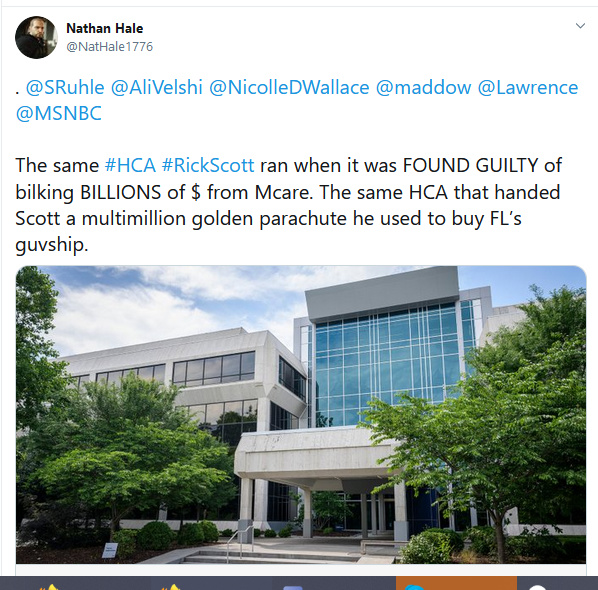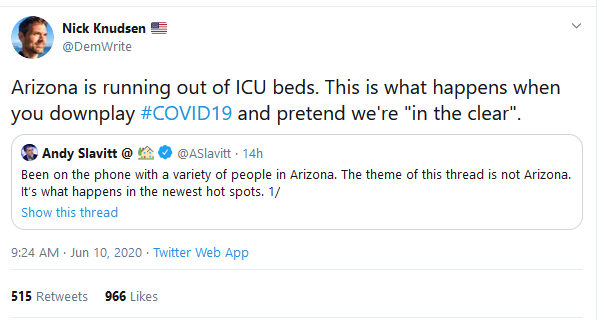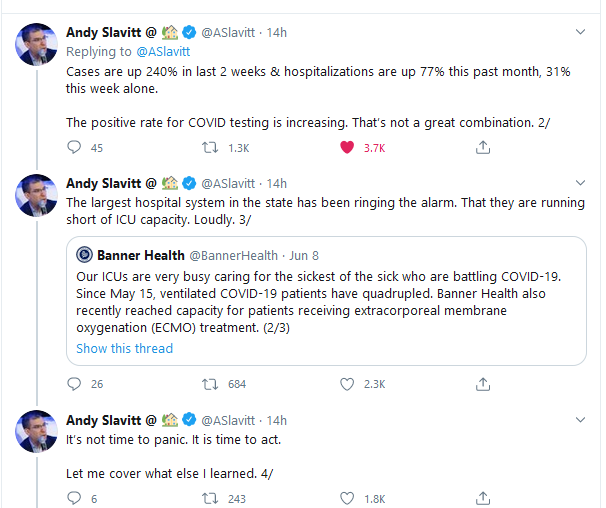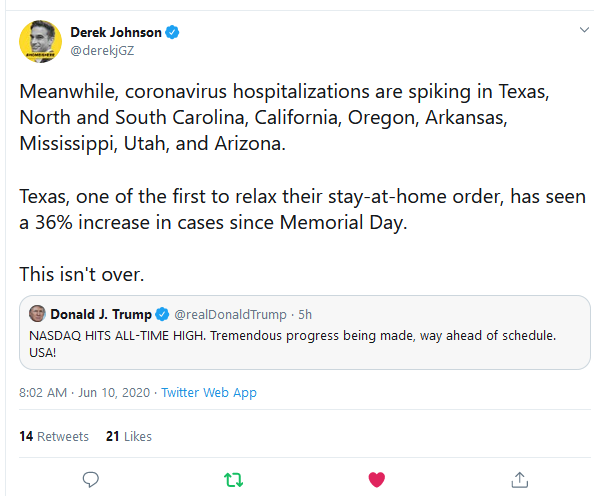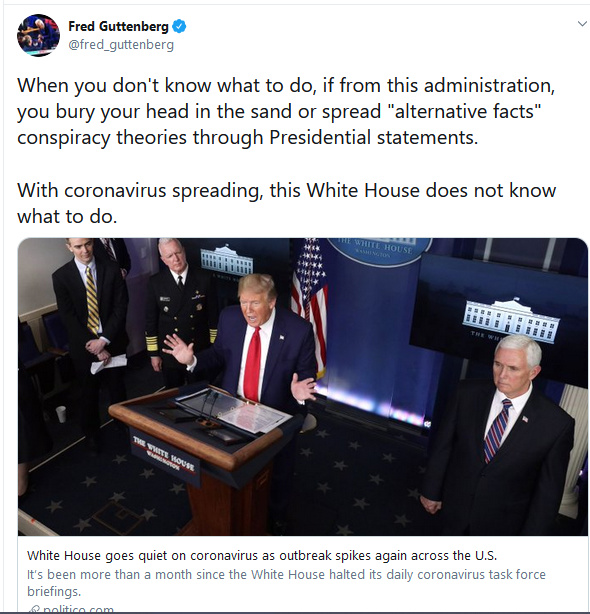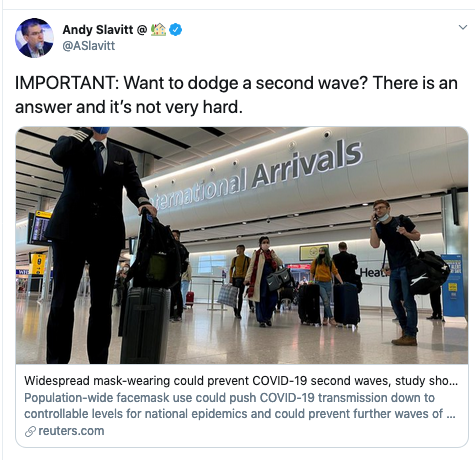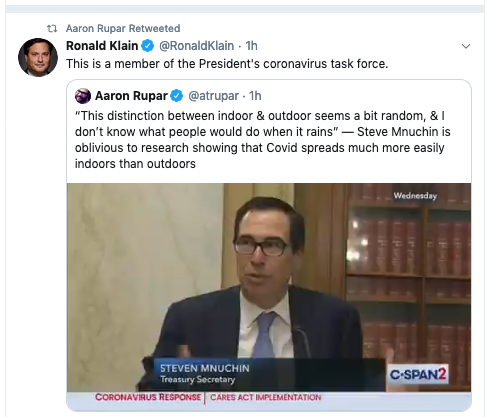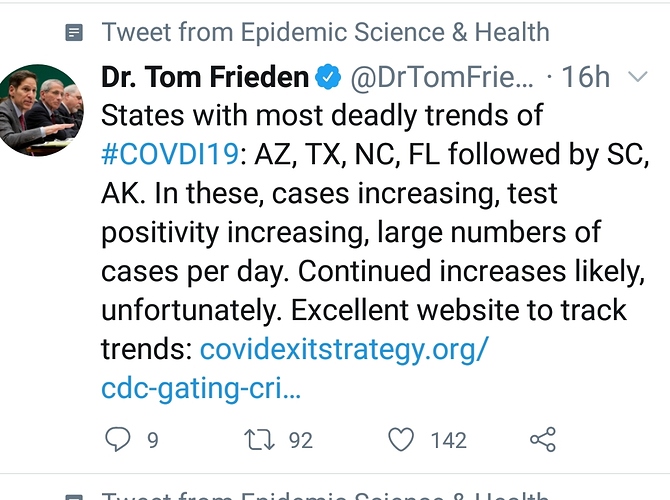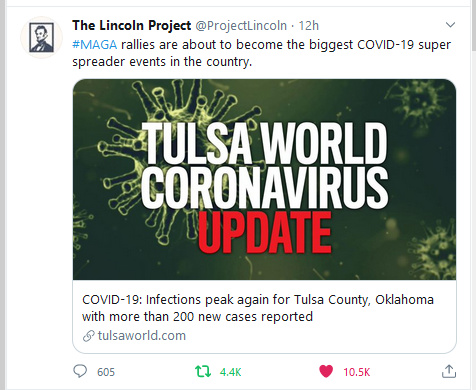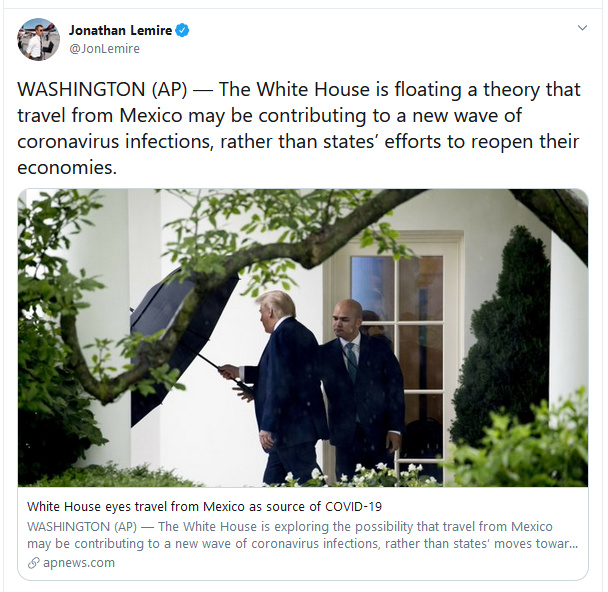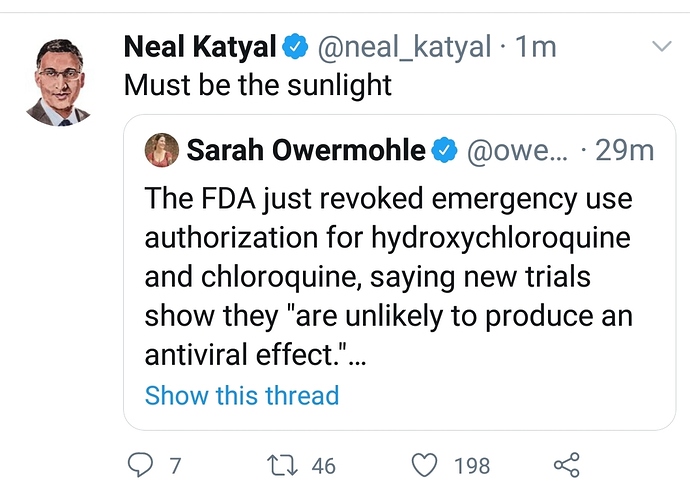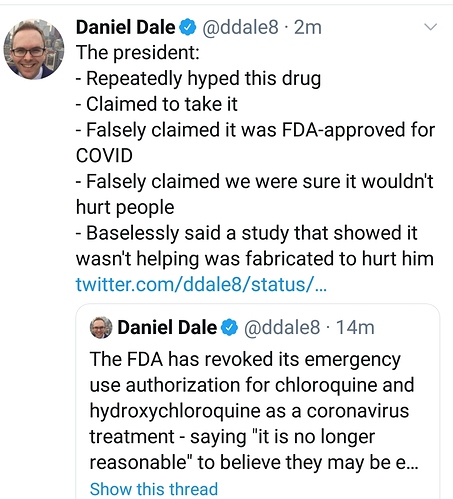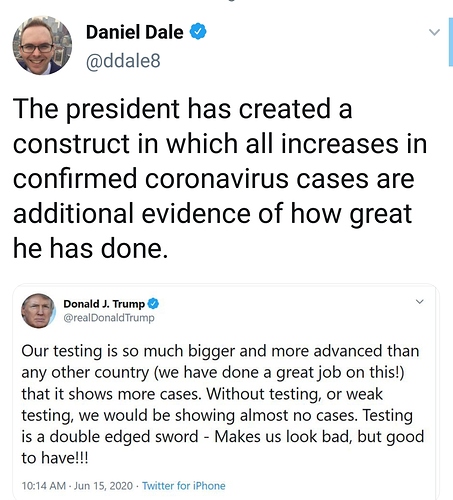Putting this right here…
When can you do many things you used to do without thinking, but now because of Coronavirus? Well, it does depend.
Many epidemiologists are already comfortable going to the doctor, socializing with small groups outside or bringing in mail, despite the coronavirus. But unless there’s an effective vaccine or treatment first, it will be more than a year before many say they will be willing to go to concerts, sporting events or religious services. And some may never greet people with hugs or handshakes again.
When epidemiologists said they expect to do these activities in their personal lives, assuming the pandemic and response unfold as they expect
Activities they said they might start doing soon
This summer 3 to 12 mos. 1 yr.+ Never again Bring in mail without precautions (n = 379) 64 16 17 3 See a doctor for a nonurgent appointment (507) 60 29 11 <1 Vacation overnight within driving distance (372) 56 26 18 <1 Get a haircut at a salon or barber shop (485) 41 39 19 1 Later in the next year
This summer 3 to 12 mos. 1 yr.+ Never again Attend a small dinner party (n = 509) 32 46 21 <1 Hike or picnic outdoors with friends (506) 31 41 27 <1 Send kids to school, camp or day care (304) 30 55 15 <1 Work in a shared office (434) 27 54 18 1 Send children on play dates (272) 23 47 29 1 Ride a subway or a bus (408) 20 40 39 1 Visit elderly relative or friend in their home (485) 20 41 39 <1 Travel by airplane (512) 20 44 37 <1 Eat at a dine-in restaurant (506) 16 56 28 <1 Exercise at a gym or fitness studio (406) 14 42 40 4 Maybe a year or more
This summer 3 to 12 mos. 1 yr.+ Never again Attend a wedding or a funeral (n = 501) 17 41 42 <1 Hug or shake hands when greeting a friend (503) 14 39 42 6 Go out with someone you don’t know well (363) 14 42 42 2 Attend a church or other religious service (220) 13 43 43 2 Stop routinely wearing a face covering (513) 7 40 52 1 Attend a sporting event, concert or play (489) 3 32 64 1 Largest values in each group are highlighted. Figures are rounded.
These are the personal opinions of a group of 511 epidemiologists and infectious disease specialists who were asked by The New York Times when they expect to resume 20 activities of daily life, assuming that the pandemic and the public health response to it unfold as they expect.
Their answers are not guidelines for the public, and incorporate respondents’ individual life circumstances, risk tolerance and expectations about when there will be widespread testing, contact tracing, treatment and vaccination for Covid-19. They said it’s these things that will determine their actions, because the virus sets the timeline. “The answers have nothing to do with calendar time,” said Kristi McClamroch of the University at Albany.
Still, as policymakers lift restrictions and protests break out nationwide over police brutality, epidemiologists must make their own decisions about what they will do, despite the uncertainty — just like everyone else. They are more likely, though, to be immersed in the data about Covid-19 and have training on the dynamics of infectious disease and how to think about risk.
They mostly agreed that outdoor activities and small groups were safer than being indoors or in a crowd, and that masks would be necessary for a long time.
“Fresh air, sun, socialization and a healthy activity will be just as important for my mental health as my physical well-being,” said Anala Gossai, a scientist at Flatiron Health, a health technology firm, who said she would socialize outdoors this summer.
Some said they would refrain from nearly all of the 20 activities until a vaccine for the virus had been widely distributed. Others said they would wait for a vaccine to do the indoor activities on the list.
“As much as I hate working at home, I think that working in a shared indoor space is the most dangerous thing we do,” said Sally Picciotto of the University of California, Berkeley, one of the 18 percent of respondents who said they expected to wait at least a year before returning to the office.
The responses were collected the last week of May, before the death of George Floyd in police custody spurred protests across the country. These mass gatherings are likely to cause a rise in cases, some epidemiologists said. “There’s a risk, and it’s hitting the communities hit hardest by the pandemic, and it’s heartbreaking,” said Andrew Rowland of the University of New Mexico.
For some of the activities, there was significant disagreement.
Some said hair salons were relatively safe — they aren’t usually crowded and have hygiene requirements — while others said a haircut had a high risk because of the face-to-face contact. Forty-one percent would go now or this summer, but 19 percent plan to wait at least a year. One-third said they would attend a dinner party at a friend’s home this summer (many specified outdoors with appropriate distancing), while one-fifth said they would wait more than a year, potentially until there was a vaccine.
Epidemiologists say they are making decisions based on publicly available data for their region on things like infections and testing. Before choosing whether to do an activity, they might evaluate whether people are wearing masks, whether physical distancing is possible and whether there are alternative ways to do it. Because there is a chance of a second wave of infections, they say they may become less comfortable with certain activities over time, not more.
Like everyone, they are also weighing practical considerations. Those who are required to go to an office or hospital every day are doing so, even if they think it would be safer to remain home. The need for child or elder care forces difficult choices. Activities that seem optional, like attending a concert, are easier to avoid. More than 70 percent of respondents said they or someone in their household was at high risk of serious illness or death from the disease.
Melissa Sharp, who recently received her doctorate, will soon fly to Europe to begin a fellowship. But for now, while she is staying in Florida with family, including high-risk relatives, she has been extraordinarily careful, “cocooning” and avoiding activities that she considers less risky than flying.
One of her quarantine hobbies, she said, has been epidemiology-inspired needlepoint: “It says, ‘Well, it depends,’ because that’s really our slogan.”
The scientists are weighing coronavirus risks against the benefits of certain activities, including emotional well-being. While both funerals and weddings carry risk by bringing together large groups of people, several said they would prioritize attending a funeral. Some are choosing to socialize or send children to camp because of benefits like mental health, education or household harmony.
Ms. Sharp said she’d consider dating after a period of confinement. “I’m young and single, and a gal can only last so long in the modern world,” she said.
For Robert A. Smith of the American Cancer Society, a haircut might be worth the risk: “It really is a trade-off between risky behavior and seeing yourself in the mirror with a mullet.”
Sometimes, their professional expertise and personal lives are colliding. Ayaz Hyder, of Ohio State University, said he was advising his mosque on how to reopen and to conduct Friday prayers. “Balancing between public health practices and religious obligations has been very eye-opening and humbling for me as an academic,” he said.
Many epidemiologists said they may never greet people the same way again. Forty-two percent of the sample said they would not hug or shake hands for more than a year, and 6 percent said they would never do either again.
“The worst casualty of the epidemic,” said Eduardo Franco of McGill University in Montreal, is the “loss of human contact.”
Others lamented it less: “Always hated those particular needless exchanges of pathogens and unwanted touching,” said Carl V. Phillips, who runs Epiphi Consulting.
About 6,000 epidemiologists were invited to participate in the survey, which was circulated to the membership of the Society for Epidemiologic Research and to individual scientists. Some said they were uncomfortable making predictions based on time because they didn’t want to guess the timing of certain treatments or infection data. “Our concern is that your multiple choice options are based only on calendar time,” 301 epidemiologists wrote in a letter. “This limits our ability to provide our expert opinions about when we will feel safe enough to stop social distancing ourselves.”
More than three-quarters of the panel said their daily work was connected with the Covid-19 pandemic in some way. Nearly three-quarters work in academia, 10 percent work in government, and the remainder work for nonprofit groups, private companies or as health care providers.
Surveys of ordinary Americans show that many people without epidemiology training also think it will be months or longer before many common activities can become routine again. A recent survey from Morning Consult found that more than a quarter of Americans would not visit a shopping mall for more than six months, and around a third would not go to a gym, movie or concert.
One thing the epidemiologists seemed to agree on was that even when they return to normal activities, they will do them differently for a long time, like socializing with friends outside or attending worship services online. A majority said it would be more than a year before they stopped routinely wearing a mask outside their homes.
People often ask when things will return to normal, said T. Christopher Bond, an associate director at Bristol Myers Squibb. “At first I told them: ‘The world has changed and will be different for a long time. This is the crisis of our lifetime and we need to embrace it,’” he said. “But that depressed them. So now I say, ‘Well, we know more every day.’”
Additional comments from epidemiologists on life and social distancing
On school, camp and day care:
NowSummerFallWinterNext spring+1 year
7%20%9%15%40%10%
“With a young child, I think the developmental risks outweigh the risk of getting sick with Covid.”
John C. Nelson, Precision for Medicine Would do it this summer
“Ideally, I’d wait until a vaccine were available, but the realities of working will probably mean that we will have to send them back when school reopens.”
Katherine Reeves, University of Massachusetts-Amherst Would wait until fall
“Willing to take more risks with this, even though it’s not a low-risk activity, as it is more ‘necessary’ than other, lower-risk activities.”
Christina Mair, University of Pittsburgh Would do it this summer
“This is a dreaded question. My kids desperately need their friends and a formal learning environment, but I don’t necessarily want to send them!”
Alicia Zagel, Children’s Minnesota Research Institute Would wait until fall
“We do not understand enough about the longer-term consequences of Covid-19 infection in children.”
Alicia Riley, University of California-San Francisco Would wait more than a year
On sporting events, concerts and plays:
NowSummerFallWinterNext spring+1 yearNever
8%2%16%64%8%1%<1%
“To me, this is a luxury and I can wait a long time until people can safely come together to enjoy it. That said, I can and will continue to support arts programs as if I was attending with donations.”
Joseph Wagner, U.S. Air Force School of Aerospace Medicine Would wait more than a year
“These are some of the highest-risk activities and probably attract more risk-embracing people. The addition of alcohol or drugs makes these activities too risky for me to consider anytime soon.”
Vivian Towe, Patient-Centered Outcomes Research Institute Would wait more than a year
“This is as much about feelings of social responsibility as about personal infection risk. Large-scale gatherings are a contact tracing nightmare and seem like they should be shut down until we have a really good sense of what’s safe/how to screen people.”
Steve Mooney, University of Washington Would wait more than a year
“I would do this IF social distancing was enforced and everyone attending was required to wear a mask.”
Tammie Nelson, Marion County Public Health Department Would wait until fall
On hugs and handshakes:
NowSummerFallWinterNext spring+1 yearNever
13%7%16%42%11%6%6%
“I would hug my friend today if she needed a hug. If my friend would benefit from a hug, I would hug her.”
Haley Holmer, World Health Organization Would do it now
“Real epidemiologists don’t shake hands. ”
T. Christopher Bond, Bristol Myers Squibb Said they would never do this again
“I think the handshake is dead. I would likely hug a few personal contacts in the distant future as a greeting where appropriate.”
Priyanka Gogna, Queen’s University Said they would never do this again
“If we have a good vaccine, perhaps the first thing I’d do is more hugs.”
Christina Ludema, Indiana University Would wait more than a year
“I prefer to greet people with a traditional greeting either with hands in a namaskar or in the Lozi tribe’s traditional greeting of clapping hands together.”
Ramya Kumar, Zambart Project Would do it now
On weddings and funerals:
NowSummerFallWinterNext spring+1 yearNever
11%8%19%42%11%<1%9%
“It makes no sense to risk people’s lives for a celebration. What a tragedy that would be.”
Claudia A. Salinas, Eli Lilly and Company Would wait more than a year
“Weddings – not until there is a vaccine. Funerals – if it was someone very close to me and the service was small, I might consider going.”
Nicole Frascino, University of North Carolina at Chapel Hill Would wait more than a year
“Depends on whose funeral. I have missed because of Covid my dad’s funeral and in a way I still regret it.”
Raluca Ionescu-Ittu, Analysis Group Inc. Would wait more than a year
“Sharing such moments is how we get to keep our humanity. I won’t refrain from being there for family and friends as long as we take extra preventive measures.”
Martine El Bejjani, American University of Beirut Would do it this summer
On airplanes:
NowSummerFallWinterNext spring+1 year
15%12%16%37%13%7%
“Unless I have absolutely no choice, I wouldn’t travel by the airplane anytime soon.”
Lilia Lukowsky, U.S. Department of Veteran’s Affairs Would wait more than a year
“A flying tube of germs.”
Chelsea Richard, South Carolina First Steps Would wait until winter
“Planning all local vacations in the future.”
Ellen Chang, Exponent Would wait more than a year
“Precautions appear adequate.”
Randall Reves, University of Colorado Would do it now
“I would bring a blanket or sheet to sit on, my own food and water, multiple masks (in case one gets uncomfortable), gloves, hand sanitizer, and wipes.”
Michaela George, George Washington University Would do it now
On meetings with new people:
NowSummerFallWinterNext spring+1 yearNever
10%8%16%42%16%2%6%
“Life has to go on at some point. While I am not dating currently, I am a 35-year-old woman. I wouldn’t want to put my personal life on hold for more than a few months when there is no end in sight for this pandemic.”
Tali Elfassy, University of Miami Would do it this summer
“This pandemic, dissertation and the state of online dating have really put a damper on my love life.”
Kendra D. Sims, Oregon State University Would do it this summer
“If I’m able to send my kids back to school in the fall, then I should be able to send myself out in the world to meet other people if necessary!”
Marilyn Tseng, Cal Poly Would wait until winter
“This is tough because dating seems less optional than, say, going to a play or the gym. There are biological clocks to worry about. So I could imagine this being safe now, ONLY IF you could be assured that the person has self-isolated for at least two weeks or more and both of you wore a mask and avoided physical contact, and the meet-up were outdoors.”
Alicia Riley, University of California-San Francisco Would do it this summer
On when to stop wearing masks:
NowSummerFallWinterNext spring+1 yearNever
11%3%21%52%7%1%4%
“When the coronavirus pandemic is over, and there aren’t any other virulent respiratory pathogens circulating, I will consider not wearing a mask in some situations. I will probably always wear a mask on a plane from now on.”
Jean Brender, Texas A&M University Would wait more than a year
“Would love for it to be sooner. I freaking hate wearing masks.”
Steve Mooney, University of Washington Would wait until winter
“It’s hard to know when it will be the right time to stop face-covering, but given it is such a small inconvenience for notable gains, I find it hard to believe that anyone is in a hurry to end this practice.”
Amy Padula, University of California-San Francisco Would wait more than a year
On visiting the elderly:
NowSummerFallWinterNext spring+1 yearNever
12%11%15%39%13%<1%9%
“It’s a long time to go without hugging my mother. But she is probably at high risk.”
Sally Picciotto, University of California, Berkeley Would wait more than a year
“This is the most difficult one.”
Clermont E. Dionne, Université Laval, Québec, Canada Would wait more than a year
“While the elderly are at increased risk of severe illness from Covid-19, we need to also be aware of the real risk of loneliness.”
Heather Limper, Vanderbilt University Medical Center Would do it this summer
“I feel most uncomfortable about this decision because it means I will have decided that the risk to them is worth it so that I can see them. ”
Mercedes Carnethon, Northwestern University Would wait until spring
